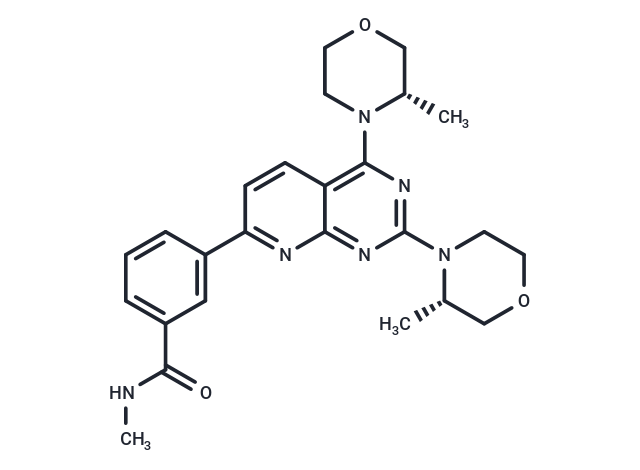Shopping Cart
- Remove All
 Your shopping cart is currently empty
Your shopping cart is currently empty

Vistusertib (AZD2014) is an orally bioavailable inhibitor of the mammalian target of rapamycin (mTOR) with potential antineoplastic activity.

| Pack Size | Price | Availability | Quantity |
|---|---|---|---|
| 1 mg | $31 | In Stock | |
| 5 mg | $68 | In Stock | |
| 10 mg | $119 | In Stock | |
| 25 mg | $183 | In Stock | |
| 50 mg | $249 | In Stock | |
| 100 mg | $397 | In Stock | |
| 200 mg | $588 | In Stock | |
| 1 mL x 10 mM (in DMSO) | $76 | In Stock |
| Description | Vistusertib (AZD2014) is an orally bioavailable inhibitor of the mammalian target of rapamycin (mTOR) with potential antineoplastic activity. |
| Targets&IC50 | pS6 (S235/236):200 nM, mTOR:2.8 nM, pAkt (S473):80 nM |
| In vitro | In the human ER+ breast cancer xenograft model, AZD2014 inhibits tumor growth by regulating the substrates of mTORC1 and mTORC2. |
| In vivo | In hormone therapy-responsive ER+ breast cancer cell lines, AZD2014 inhibits cellular growth and promotes apoptosis. It effectively suppresses the biomarkers of mTORC2, namely pAKTSer473 and pNDRG1Thr346. |
| Kinase Assay | Recombinant truncated FLAG-tagged mTOR expressed in HEK 293 cells is used in biochemical assays, together with a biotinylated p70S6K peptide substrate. Streptavidin donor and protein A acceptor beads are used to assemble the capture complex for generation of the assay signal. The activity of the lipid kinases, PI3K alpha, beta, delta, and gamma are measured using recombinant proteins and the lipid PIP2 as substrate. Assays for ATM and DNA-PK activity are performed. The mTOR cellular activity is measured in MDAMB468 cells, using an Acumen laser scanning cytometer to analyze the levels of phosphorylation of S6 (Ser235/236) and AKT (Ser473)[1]. |
| Cell Research | AZD2014 is prepared in DMSO (10 mM) and stored under nitrogen, and then diluted with appropriate media before use[1]. Cells are plated in 96-well plates for the indicated time. For CellTiterGlo assays: CellTiterGlo is mixed with the cells. Cells are normalized to day 0 control and net growth is determined using the following formula: ((x?y)/(z?y))=net growth, where x=reading of treated sample at end of study, y=average reading on day 0, and z=reading of DMSO-treated sample at end of study. The concentration of DMSO does not exceed 0.03% for any experiment. For MTS assays: adherent cell lines are grown in 96-well plates. MTS reagent is added on day 0 and on day 3 post-AZD2014 addition. Suspension lines are assayed using the Alamar Blue reagent, 72 hours after AZD2014 addition[1]. |
| Alias | AZD2014 |
| Molecular Weight | 462.54 |
| Formula | C25H30N6O3 |
| Cas No. | 1009298-59-2 |
| Smiles | CNC(=O)c1cccc(c1)-c1ccc2c(nc(nc2n1)N1CCOC[C@@H]1C)N1CCOC[C@@H]1C |
| Relative Density. | 1.231 g/cm3 |
| Storage | store at low temperature | Powder: -20°C for 3 years | In solvent: -80°C for 1 year | Shipping with blue ice. | ||||||||||||||||||||||||||||||
| Solubility Information | DMSO: 36 mg/mL (77.83 mM), Sonication is recommended. H2O: < 1 mg/mL (insoluble or slightly soluble) Ethanol: < 1 mg/mL (insoluble or slightly soluble) | ||||||||||||||||||||||||||||||
Solution Preparation Table | |||||||||||||||||||||||||||||||
DMSO
| |||||||||||||||||||||||||||||||

Copyright © 2015-2025 TargetMol Chemicals Inc. All Rights Reserved.